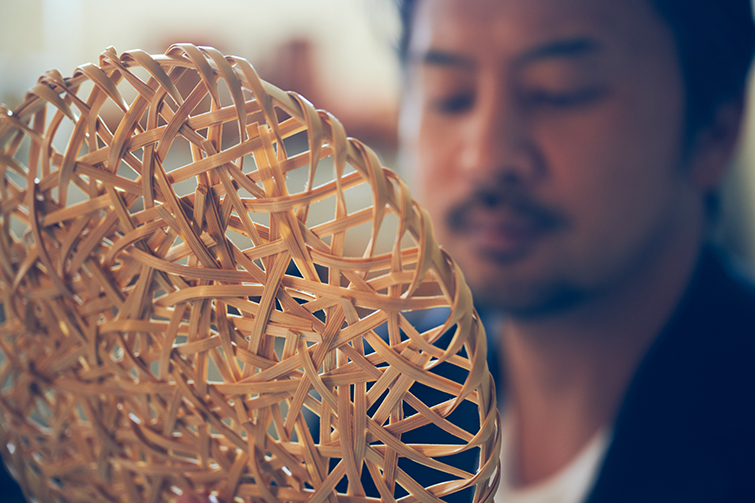Speed more than two hours in the hushed comfort of an ultra-fast bullet train beyond Tokyo to arrive in Kyoto. It's a city that permeates a different energy than the capital of Japan; Kyoto pulses with serenity and tranquility to inspire its residents and tourists.
Kyoto's energy is unmistakable, yet the city's history is undeniable. It seamlessly blends past and future and effortlessly strikes a rare balance between both that few cities can.
For the INFINITI global design team, Kyoto is a special place. More than its nature, timeless structures and monuments, it's the people in Kyoto toiling to maintain Japan's unique approach to art. Their innovative approaches deliver their own concept of modern Japanese luxury and serves as a guidepost for INFINTI's designers.
It is here that a collective of artisans work to create objects that not only deliver a nod to the past but also employ modern techniques to ensure their future relevance. In many ways, INFINITI shares common values with this group, from their passion for exploring new and unconventional ways to their design philosophies and their underlying desire for continual progress.
INFINITI Kyoto Makers, from left to right: Housai Matsubayashi, Toru Tsuji, Takahiro Yagi, Taisuke Nakamura, Eriko Horiki, Shuji Nakagawa, Tatsuyuki Kosuga,
It's these reasons that INFINITI Senior Design Director Taisuke Nakamura recently sat down for a wide-ranging discussion with six Kyoto-based artisans to explore their mutual appreciation for nature, innovation, and to hear their thoughts on modern Japanese luxury.
That roundtable is the continuation of INFINITI's successful series, "The Makers." Beyond mere inspiration, the first season recap of "The Makers" focuses intently on the connection between people and products, between artisans and their art.
It's a relationship Nakamura knows well. As INFINITI's head of global design, he leads a team that is inspired by the brand's homeland to craft designs embedded with a subtle Japanese essence to stir emotion, create human connection, and deliver a sense of harmony.
Kyoto-based artisans Tatsuyuki Kosuga, Shuji Nakagawa, Eriko Horiki, Takahiro Yagi, Toru Tsuji, and Hosai Matsubayashi joined Nakamura-san to delve deeper into what makes Kyoto unique and admired among designers and artisans as part of the in-depth series.
"What we are doing, and what we have been doing, is carrying this tradition on our backs and preserving this craft while adapting to the times," says Yagi-san, a sixth-generation tea caddy maker from Kyoto. His caddies are highly prized for their precision and manufacturing processes, which each apprentice can take a decade or longer to learn.



Horiki-san relates a similar perspective in her craft, washi, a traditional papermaking method in Japan. Horiki-san recalls a commission to make washi beyond her workshop's capacities; she rented a nearby workshop to make the paper that came with a warning.
"I was told, 'Please don't call whatever you're making a traditional craft,'" Hoirki recalls. "‘The washi you make is totally different from the washi we make.' I turned completely pale. There was someone saying not to call it tradition when I'm trying to keep the tradition alive."
Horiki's faith in innovation is a point of pride in her famous work and it's mirrored in other crafts in Kyoto. After all, washi was an innovation itself more than 1,300 years ago, she says. Innovating today keeps washi alive for 100, 500, or 1,000 years longer.
That type of perspective on time could only come from a place like Kyoto, where timelines are measured by millennia — not just generations. That long view permeates into the products manufactured there and contributes to the sense of something bigger, something more beautiful than just an object.



There's a natural evolution to the world and people, the makers say, that goes beyond their products and transcends their functions to be beautiful in their forms.
"I don't look at it from the perspective of traditional crafts, I see it as something that's beautiful … and aesthetic," says Tsuji-san, whose wirework is intricately beautiful but also very useful.
That lends itself to a direct relationship between what's luxury and the world around it.
"I feel it's important for luxury to be real," says Horiki-san. "And if you're wondering what ‘real' is, the finished product is beautiful, but the process of manufacturing is also beautiful. And the tools are beautiful … and the aging process is beautiful. Each and every process is beautiful and that's what's real."
It all leads to a higher calling for Kyoto and its artisans, echoed in the INFINITI vehicles whose design team often draws inspiration from the city.
"I hope that the products that are made with such care and attention to detail are shared with the world we can go beyond any religion or ideology," says Nakagawa. "It's not just about connecting people and countries but connecting people through our craft. We have that kind of potential."


That connection between INFINITI and Kyoto is at the heart of its vehicles. The energy and essence of Kyoto, and its resident artisans, is reflected in the bold design direction INFINITI is headed thanks to Nakamura and his team.
# # #
About INFINITI
INFINITI Motor Company is headquartered in Yokohama, Japan with operations around the world including regional offices based in the Americas, China and INFINITI International Markets based in Dubai. The INFINITI brand of premium automobiles are assembled in manufacturing facilities in Japan, North America and China. INFINITI design studios are located in Atsugi-Shi near Yokohama, London, San Diego and Beijing.
More information about INFINITI and its industry leading technologies can be found at www.INFINITIUSA.com. You can also follow INFINITI on Facebook, Instagram, LinkedIn, Twitter, and see all of our latest videos on YouTube.
Contacts - INFINITI Communications
Aileen Clarke
Manager, INFINITI U.S. Product and Brand Communications
949-359-1112
aileen.clarke@infiniti.com






































































































































































































































